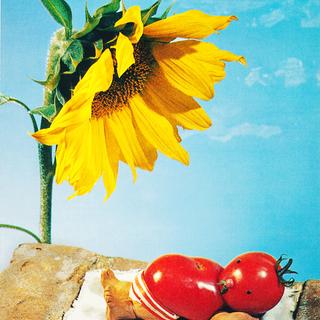


'King of kitsch' Henry Rox and his delirious garden
In picturesHenry Rox, a German Jew exiled to the United States in the 1930s, immortalized his surreal sculptures of bananas, lemons, leeks, asparagus and onions. After falling into oblivion, his work was rediscovered in 2020 by the German collector Wolfgang Vollmer.
This is the story of a man who devoted his entire adult life to playing with food. Born in Berlin in 1899 as Heinrich Rosenberg and died in the US in 1967, Henry Rox was a sculptor, scenographer and studio photographer. His vivid color pictures, which earned him the nickname "king of kitsch," were filled with fruit and vegetables. His photos would surely have been a hit on Instagram.
In one of them, five carrots are entwined to create the illusion of a seated elephant. The ridges on the surface of the vegetable's skin are reminiscent of the pachyderm's fat folds; two small bananas, symmetrically placed opposite each other, play the role of tusks and complete the animal's portrait.
In another, the silhouette of a singer is revealed behind the mask of a leek. Placed upside down and balanced on a checkerboard floor, the ugly vegetable suddenly becomes graceful: Below, its long sheathing leaves, arranged in a fan pattern, conjure the image of an evening gown; above, its rootlets mimic hair, epaulets; at the end of a metal stem, a radish is used as a microphone.
Reminiscent of Giuseppe Arcimboldo
The edible creations continue: a fakir (a banana bent over a carpet of nails), a lamb with dense red wool (made entirely of redcurrants), an orange-headed sailor sailing his boat in the moonlight (a quarter of a watermelon), a peanut man cooling off in the bathtub (half a grapefruit) and a disproportionately-headed little girl (an onion) crying her eyes out (onions again) in front of a mirror.
It's hard not to be reminded of the compositions of the Italian painter Giuseppe Arcimboldo, who, in the 16th century, used fruit and vegetables to fashion portraits that were at once ironic and mysterious. It's also hard not to find a form of modernity in these naive, playful images, especially at a time when our social media feeds are full of animals represented as food – like the Instagram account @sibatable, which shapes noodles, vegetables or eggs into cute animals emblematic of kawaii culture. Or the vogue for poodles recreated with spaghetti dishes. Or contemporary furniture pieces sculpted from the ingredients needed to make sushi. The list goes on and on.
It's also amusing to note the parallels between 2020s Internet users and an early 20th-century artist with a very niche destiny. Rox was a contemporary of the Dada movement and the Surrealists, to whom it might be tempting to compare his work, notably to René Magritte's The Listening Room or to the photomontages of Max Ernst, Hannah Höch and Raoul Hausmann. Born into a family of Jewish Berlin merchants, the artist emigrated first to London and then to the US in the wake of the rise of Nazism in Germany in the 1930s.
You have 30% of this article left to read. The rest is for subscribers only.
